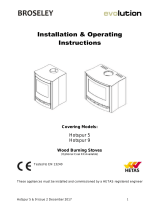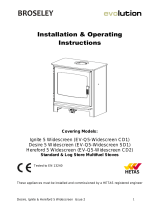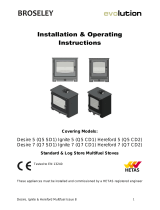Page is loading ...

Mounting and User Instructions
Lotus Jubilee Series Stoves
Version 1, 06/10-2014


Introduction
Congratulations on your new Lotus Wood Stove
We sincerely trust that your Lotus Wood Stove will bring many happy hours for
you. However, to benefit fully from your investment, you should read these
instructions thoroughly. They contain some specific advice on how to benefit
fully from your stove – now, and in the years ahead. So, like all other directions
for use, keeping them in a safe place would be a good idea.
Lotus Wood Stoves are based on a long tradition; the first productions were way
back in 1979. Our production is now run in Langeskov on Funen in Denmark,
and is exported to a great many European markets. Our stoves are produced to
sound Danish tradition, and have given their owners good and reliable service
for years. So, once again, congratulations on your new Lotus wood stove. We
feel certain that putting your Lotus wood stove in operation will inaugurate a
warm and cosy beginning of a new home life for you.
The stove is intended for ”intermittent combustion”, a process achieved by
following the instructions of the guide below under “Use of Stove”.
Mounting of Stove
Before your new stove will be ready to exude warmth and cosiness, you should
read these pages thoroughly. Pages reviewing the requirements for the mounting
and for the surroundings. Reference is also made to the fact that local
regulations, including those referring to national and European standards,
applying at all times must be met for the installation of your wood stove.
A warning should also be issued against any unauthorized change of your wood
stove. It should be added that the surfaces of your wood stove will become hot.
Lotus recommends that your stove be mounted by an authorized Lotus
distributor or by a fireplace service man recommended by an authorized Lotus
distributor.
NOTE: Your stove may not be put into use until the installation has been
approved by the local chimney sweep.

Further, please note that any air grates are to be placed so as not to block.
Distance to Combustible Material
For combustible material, such as combustible walls, furniture, etc., for reasons
of safety a number of minimum distances apply. The following minimum
distances apply to the Lotus Jubilee series:
A: 100 mm B: 170 mm behind stove C: 310 mm beside stove 1300 mm forward
Distance to non-combustible material
To non-combustible material, there should be a distance of 80-10 mm in order
that the stove may release and distribute the heat while you may clean on and
around the stove.
Technical Specifications
Model Height Width Depth Weight
Jubilee 35 1072 724 454 192
Jubilee 35 S 1102 724 454 243
Jubilee 35 M 1420 724 454 358
Jubilee BF 1394 724 454 236
Jubilee M BF 1424 724 454 300
Mean Values at testing to DS/EN 13240:
Flue Gas Temperature: 283 C
Flue Gas Mass Flow: 5,4 g/s
Rate of Efficiency: 82%
Rated Output: 7 Kw

Flue: 12 Pa
Chimney
A good draught in your chimney is paramount to how well a stove will burn.
Note that there should be access to cleaning doors.
The effective height of your chimney should typically range between 3.5 and
4.5 metres. Effective height is to be understood as the distance from the stove
top to the top of the chimney. The inside diameter of the chimney should be
min. 150 mm (inside dimension) in steel chimneys and min. 175-180 mm in
brick chimneys or chimneys of ceramic elements as their inside surfaces will
frequently be rough and offer resistance.
All joints and connection points shall, of course, be tight, and the chimney shall
be able to provide a draught of a min. 1.2 mm water column (12 Pa).
The wood stove may be connected to chimneys which are also used for other
purposes. To this end, the specific local conditions shall be assessed by a fitter
and/or chimney sweep.
Register
If your chimney has a register, it should have a forced aperture of min. 20 cm
2
.
Smoke baffle plate
The smoke baffle plate are removed by lifting up at one side after which the
part may come clear at the other side and be taken down into the combustion
chamber and out of the door. Similarly, it is to be put in place by leading it up
slanting-wise at one side, and then at the other side, and then put into place in
the middle.
Combustion Air Supply
It is important for good and clean burning that adequate air be supplied to the
fire. To allow for this, it is, however a condition that air be supplied to the room
in which the stove has been set up.
Certainly most rooms will have sufficient air, not least if some of the doors
between the rooms of the house are open. In special cases, an air valve may
have to be put in the exterior wall of the room in which the stove has been put
up.

Floor
Note that it is a matter of a heavy stove, and it should be ensured that the floor
has the carrying capacity required.
When placing your new Lotus stove on the floor, it should be put on a non-
combustible plate, for instance of steel or stone material. The plate should be so
large that it will reach a minimum of 30 cm in front of the stove, and 15 cm at
each side of the fireplace opening.
Chimney Sweep
When your new stove has been mounted, do remember to report the installation
to the chimney sweep. For one thing, the installation will have to be inspected,
and the chimney should also be cleaned by the chimney sweep in the time
ahead.
Use of Stove
Below, the procedure applied at the stove testing at the EN Test.
This is the procedure generating optimal combustion on the particular chimney.
Wood quantity and register setting may be varied as individually required for
heating and the draught of the particular chimney.
The stove has been tested with birch wood of a humidity of appr. 18%.
Kindling and Current Stoking at DS testing
1. Put about 2-2, 2 kg kindling wood into the bottom of the stove, stacked
crisscross like a log house. Put 2 fire-lighters in the middle, and ignite them.
2. Close the door ajar, leaving an aperture of appr. 2 cm. Open the register to the
right under the door completely (turning it to the right all the way). Leave the
stove like this for about 8-10 minutes before closing the door completely and
turning the handle into locked position.
3. The register is damped as required during the kindling (by pushing it towards
the left).
4. When the fire has burned down to embers (no more flames), open the door
gently so as not to whirl out the embers. Spread out the embers cautiously
using a poker so as to leave them in an even layer.
5. Put two pieces of wood into the stove, totally about 1.8 kg. The pieces will
ignite best if they have a split side facing the door, and one down in the
embers. Close the door immediately and completely.
6. Open the register completely, and after about two minutes set the register so
as to be about half open Just how open the register should be may vary with

the draught of the particular chimney but the flames should now stabilize into
a ”calmly burning fire”.
7. When the wood has burned down to embers (after about one hour), start all
over from item 5.
Slow Combustion
On a proper layer of embers feed a fair quantity of wood (2.5 – 3 kg distributed
on 2-3 pieces of wood – not one or two big logs). When the fire has caught on
well, adjust the air down. Never adjust down more than still leaving clear,
lasting flames. When this fire has burned down, the period up to the next
stoking may be stretched further by closing the register entirely so that cold air
will not be pulled through the stove.
Adjusting the air supply down too early, or if it is generally too small, will
cause a poor rate of efficiency and a too high emission level to the detriment of
the environment.
Ashes
Ashes may be discarded in the waste bin for refuse collection. The ashes should
always have cooled for 24 to 48 hours before being thrown into the waste bin as
there may otherwise still be embers that may ignite waste or the waste bag.
Sound Advice
Kindling after a protracted interval
If your stove has not been used for some considerable time, the chimney should
be inspected for blocking prior to rekindling.
Cleaning of Stove
All Lotus stoves have been factory surface treated with original Senotherm
lacquer in “coke” or “grey” colour. Due to this treatment, the stove will, during
the first kindlings, exude a special odour but that will vanish after a few times.
Good airing to be provided.
The painted surface is maintained by brushing it using a soft, long-haired auto
brush or by using the vacuum cleaner with a brush.

The soapstones may be cleaned – not using rough detergents – but a little spray
for window cleaning. Any small scratch may be cautiously polished down using
very fine sandpaper.
Your stove should also be cleaned inside regularly. Ashes, soot, and any tar
residues are to be removed from the pane and the combustion chamber. Smoke
baffle plates should be dismantled regularly to remove soot and dirt which will
frequently settle behind the plates. Check at the same time whether there is free
passage to the chimney. The ash pan should also be emptied regularly as
required. The ashes from the wood stove may contain embers long after the
stove was used last time so always put the ashes in a fireproof bucket prior to
removal. Do remember that your stove should be cleaned in cold condition
only.
Chimney Fire
In case of a chimney fire, doors and register should be shut so as to cut off the
oxygen supply. Relevant authorities etc. may be called if necessary.
Stove Maintenance – use original spare parts only
Packing’s may seem to look nice; they will, however, collapse in the heat,
thereby losing their ability to keep your stove tight. Packing’s should be
replaced as required as it is essential to good combustion and to a clean pane
that your stove is tight.
The combustion chamber covering may break or become worn. The panels
are made of vermiculite, an insulation material. When worn, the material is to
be replaced not later than when the panels have a thickness of appr. 1.5-2.0 cm.
The material is slightly porous. To prevent breaking of the panels it should be
ensured that the wood is not thrown but laid in the middle of the combustion
chamber. If you happen to break a vermiculite panel, this will not have any
impact on the insulating effect of the panel.
Painting of your stove using Senotherm spray may cover stains or small
scratches from kettles or other. Heavy damage to be ground with fine steel
wool, vacuum cleaned, and then sprayed. Shake the spray can very heavily, and
spray on at a distance of 15-20 cm. It is most important that your stove will be
out of operation and quite cold before you use your spray, otherwise heavy
damage may be inflicted on account of fire risk.

Kindling Wood
Kindling wood is the designation for finely split small wood/sticks some 20-30
cm long and having a diameter of 2-3 cm.
Wood
Birch, beech, oak, ash, elm, as well as fruit trees are all suitable for being
chopped into firewood.
Pressure impregnated wood, chipboard, coloured leaflets or glazed paper are,
however, not suitable in a stove. They will develop hydrochloride acid or heavy
metals much to the detriment of your stove and to the environment.
Wood for your Lotus stove should have a diameter of 7-9 cm and be max. 30
cm long as it will otherwise come too close to the stove sides (at the DS testing
30 cm long wood has been used). The most important aspect of good
combustion is that your wood will be appropriately dry (of a humidity of 15-
20%). If your wood is too wet, making it burn will be hard, the chimney
draught will not occur, there will be a lot of smoke, and utilization will be low
as water will need to evaporate first. This is certainly harmful to the
environment and will cause a high level of emission. Further, it may cause
damage to your stove and chimney by way of shining soot and tar coverings.
“Worst Case” would be a chimney fire. If your wood is far too dry, it will burn
too quickly. Frequently the gases in the wood will be released quicker than they
will burn, and some part of these will go up the chimney unburned. Thus
yielding a lower rate of utilization and harming the environment.
So it is a matter of a balance which is, however, reasonably easy to find with a
little practice.
Also please refer to the comments below under Storage.
Storage of Wood
The best storage of the wood is under roof though still with good airing, for
instance in a car port or under a shed roof. Preferably put your wood on a
wooden pallet or similar, clear of the ground. Fresh wood, sawn and chopped,
should preferably be left in this manner for one or two years depending on the
species of wood.

Items available in stove
In the stove, the present mounting and user instructions are available, as well as
a glove good for stoking.
Operating Trouble
If case of any operating trouble with your Lotus stove, you may find the cause
of that below. If not, please do not hesitate to contact your Lotus distributor.
Stove hard to control – burning too quickly
If your stove is new, check our guide.
If your stove is more than one year old, or if it has been used heavily, the seals
may have to be replaced. If the seals are on for too long, the heat will cause the
seals to lose their ability to keep your stove tight.
Stove drawing badly after installation
Check that the mounting instructions have been followed. In particular,
conditions around the chimney may cause trouble. Are the diameter and the
length OK, is it tight, and are the flue pipes and the transitions tight? A chimney
sweep may have to be contacted to remedy the problem as the chimney may be
clogged.
Smelling of Smoke and Soot
This may be due to wind down draught in the chimney and will mostly occur in
certain wind directions. The chimney may be too short in relation to the roof
ridge, or trees may have grown up and may be causing turbulence.
Your stove is hard to make burn and may go out
There may be a number of reasons for this. The most typical ones are:
The register is not open enough.
The wood is too wet.
The chimney draught is too small; it may be clogged or leaky.
The layer of embers was too small/no longer glowing and did not produce heat
enough to kindle the pieces of wood.
Depending on the type of problem you may have to contact your Lotus
distributor or a chimney sweep.

WARRANTY
Lotus Wood Stove – 10-Year Warranty
From 1 September 2014, Lotus is offering a 10-year warranty instead of a five-year
warranty. This warranty applies to stoves which are supplied by Lotus after this date.
This warranty covers Lotus Wood Stove model _________ production no.
_____________ purchased on the ____________.
This warranty covers normal firing – i.e. using ordinary chopped wood and pressed
wood briquettes, and only provided the stove is otherwise operated to the
specifications of the directions for use.
This warranty covers the faultless function of the stove, and does not cover
overheating damage, damage to lacquer, wearing parts and movable parts such as
glass, Skamol, stones, shaker grate, smoke baffle plates, packings, slide gate, and
closing gear.
This warranty shall lapse if this stove is not operated so as to comply with the
directions for use, and if deficiencies or similar are aimed to be/are remedied by a
person not authorized by Lotus Heating Systems A/S. This warranty does not cover
damage caused by inappropriate, non-expert/incompetent use of the stove.
If a product is returned to Lotus Heating Systems A/S, and the damage subsequently
turns out not to be covered by this warranty, any costs incurred shall be incumbent on
the customer.
For any warranty repair, the warranty period for the repair carried out shall not be
extended but shall continue to follow the original warranty period.
This warranty shall be valid only if duly completed and subject to simultaneous
presentation of distributor’s original invoice. The warranty period shall follow the
invoice date.
Congratulations on your new Lotus Wood Stove.
Yours Sincerely, Distributor:

Johnny Ebstrup
Lotus Heating Systems A/S
/




